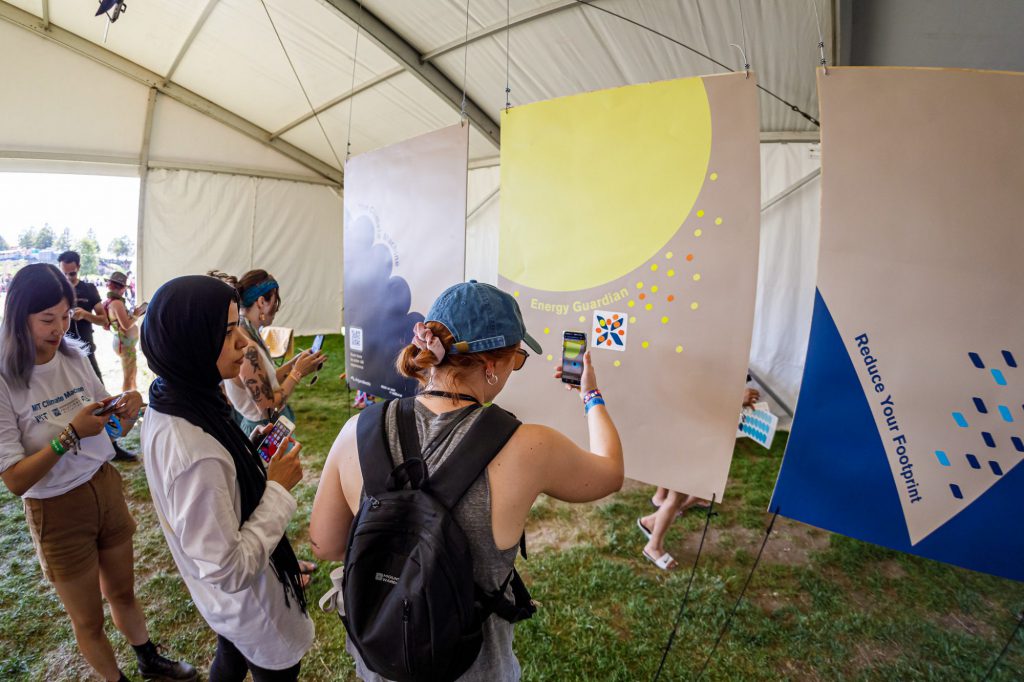Nourey is sitting at the intersection of science and sound, and we chatted with her and Dr. John Fernández to discuss climate change.
As ravers, we love to create these isolated pockets of space where we can celebrate the music we love, free from social stigma and pressures from the outside world. No matter how hard we dance and how loud we turn up the music to drown things out, there are certain things we can’t ignore. This past weekend, many attended Bass Canyon at the iconic Gorge Amphitheatre in Washington – a venue every music lover should visit at least once. The combination of incredible acoustic design and breathtaking views of the Columbia River Valley blends the mastery of human musical architecture and nature’s design in a way that truly needs to be seen and felt to be believed.
A certain chill pulls the hairs on the back of your neck as you trek up the hill for the first time, music blasting clearer and clearer as you get closer and closer to the top. You inhale and feel that first gust of wind from the valley’s depths as if breathing life into you. It’s a sensory experience that could have even a staunch atheist believing in divine intervention. And yet, last Saturday brought a dark overcast as wind patterns carried large pockets of smoke from the wildfires burning throughout Canada and into the US. Many were robbed of that gorgeous view by thick smoke; their first inhale was charred by literal breathtaking air.
The fires have been blazing throughout most of the summer, reducing visibility and air quality everywhere from Toronto to New York City, even as far west as Seattle and Vancouver, and of course, The Gorge. The New York Times has had a live map for most of the summer, featuring how the fires have moved since late May. It’s damning stuff, as July was officially the hottest recorded month in human history. This year’s wildfire season started earlier and has been going longer than usual.
Yet, for producer and Ph.D. Nourey, alongside the team at the M.I.T. Environmental Solutions Initiative headed by Dr. John Fernández, dance music can be a force to help combat the growing climate threat instead of just an escape from it. It was at this exact venue just a month ago, during Above & Beyond’s Group Therapy Weekender, when we caught up with her and Dr. Fernandez.
We chatted as they set up their latest foray into combating the global climate crisis alongside the dance music giant Anjunabeats. As we dive into her work outside of music, first and foremost, listen to her ambient set from Group Therapy Weekender or her Meant To Be EP, a beautiful and emotive piece of dance music combining deep house, ambient, and breakbeats!
Stream Nourey’s Ambient Set from Group Therapy Weekender on SoundCloud:
We have Nourey here, along with her professor at M.I.T., Dr. John Fernández. Nour, for those of us who are unfamiliar with your work, tell us a bit about this project!
Nourey: My name is Norhan, but I go by Nour. I currently work at the MIT Environmental Solutions Initiative, the center that Dr. Fernández is directing. We started this project in 2020, when I first joined Anjunabeats, to understand how we can work with the music industry to improve their sustainability initiatives. We’ve been collaborating with them to understand what kind of [activities] we can do for music festivals, such as Group Therapy Weekender, to enrich their fanbase engagement with climate action. We started last year with the first program, where we used augmented reality to increase awareness on four topics: energy, emission, waste, and biodiversity. This year, we’re expanding into virtual reality, as well as projection mapping.
How did that idea of seeing what we could do with the festival and nightlife industry and the initiatives to reduce their impact formulate in your mind?
N: So this was actually a mutual agreement between us (gesturing to Dr. Fernández), so why don’t you join in?
Dr. John Fernández: I can start! One motivation is that a music festival is, in essence, a world separate from the usual. The music festival makes its own world and generally speaking, that world is one that you prefer, you’d like the world to be like. The Anjunafamily makes a world that’s centered on doing good in the world, making a better world, so that to us was so ripe for a climate message that part of making a better world and having this experience is knowing we can make our climate better. How might we do that? That’s where we step in with things you can do, with specifics and technologies and human behavior. That’s also where the AR (augmented reality) comes in: Then you can connect your own interests with an experience, and that experience will take you into options of what you can do!

Incredible! It’s also kind of cool to think about music festivals logistically: it’s an energy sink. Massive lights and production, heating, cooling, the ins and outs of running things like that, what made you think that Anjuna was the label to start working with as you eventually seek to branch out into more sectors of the dance music realm?
N: I’ve been following Anjunabeats and Above & Beyond since about 2001, and I was always inspired by the Anjunafamily: how a group of people are very connected and are inspired by all good things – like accepting each other and being positive, the gratitude aspects – make it a perfect society to work with because you’re in this positive setup where people are inspired to do something good. You see this at The Weekender and other events. That’s why it’s incredibly inspiring.
Dr F: The other thing about music festivals is that generally, in curating an “ideal world,” this makes it an ideal testing ground for implementing new technologies and observing behaviors. Right now, music festivals are just beginning to implement renewable energy technologies. We’re at an inflection point. It’s still easier in practice to chuck in the generators, but very soon, there can be a shift.
That shift can be the use of fuels such as Green Hydrogen, for example, which is an ideal fuel for a remote location [such as The Gorge]. Green Hydrogen, when combusted, turns its waste into water, leaving no pollution whatsoever, so the idea of using music festivals as relatively modest, small-scale, test beds is really fantastic. Some bands are already playing with the idea of alternative fuels, such as harvesting the kinetic energy of their crowds dancing!
Do you see something coming in the next few years, such as venues like this getting things like solar cells for their stages and figuring out how to store it and keep it? And do you think that’s something that happens in five years, ten years? Are we looking at a generational shift?
Dr. F: We’re in that generational shift right now actually, in five to ten years, absolutely. The future will be uneven. In other words, some real leaders in the music industry will try to take their music festivals down to net zero (ecological impact), which will be super hard and doesn’t need to be *quite* net zero. If it’s close, that’s great; that’s a huge advancement, and after that, others will follow. If a critical mass of leaders and big artists act on this, it will move the industry, especially with live music events.
We remember at the height of the pandemic, you all did a summit where you sat down with Tony McGuinness of Above & Beyond. How did you get MIT and Anjunabeats to come together in the initial discussion?
N: When we started the initial discussion, I pitched the idea of how MIT could work with an influential label like Anjunabeats. Conveniently enough, they were also thinking of designing sustainability initiatives on their operations side, so the timing worked out well, and the collaboration worked out to be mutual!
Large topics aside, at Weekender, you’re playing two sets at The Meadow, one on Saturday that’s clubbier and one on Sunday that’s more ambient. Tell us a little bit about the music you like to play and the music you like to produce!
N: Right now, I’m exploring a few different genres, such as ambient electronica. I’m trying to write an album right now that’ll be a testament to all of my influences. With my sets, I like to focus on playing multiple genres in the same set. I like to start out with IDM, then shift to trance and techno, and even drum and bass. On the production side, I’d like to explore all these genres more, making different tracks than I used to make and getting out of my comfort zone more!
So besides that, is there anyone on the lineup that you’re looking forward to seeing?
N: I’m definitely excited to see Tinlicker and Yotto, as I’ve never seen them before, and I’m always excited to see Above & Beyond!

As we continue to lobby for sustainability, it’s important for us not to be disillusioned.
It may seem like a daunting task to push for more and more regulation and sustainability, but the truth of the matter is that our dollars speak louder. The more awareness we bring to our fellow ravers, the more that we bring to large dance music and nightlife leaders – that we want more things such as solar cells, Green Hydrogen generators, and kinetic floors, and how that will impact our spending habits – the faster they’ll shift to implement them on a large scale.
The music industry is one of the most accessible avenues for large-scale change for the average person. Every successful event we push to implement sustainable solutions drives the market, potentially forcing these technologies to become cheaper. As a result, more mass production will be implemented, and more research will be funded to push for an issue that affects us all. Anjunabeats has been one of the leading voices in the industry on this front.
In 2022, Above & Beyond entered the foray into film-scoring alongside the trio’s long-time friend, producer, and composer Darren Tate with the soundtrack The Last Glaciers for the documentary film of the same name. Despite the urgency in its message, it combines live and electronic elements for an optimistic call to action amid the climate change crisis affecting the snowy mountains and glaciers across the Himalayas, Alps, and other Arctic and Antarctic regions.
The combination of efforts from Anjunabeats, Nourey, and the MIT Environmental Solutions Initiative team led by Dr. Fernández seeks to be at the forefront of dealing with a problem that we can combat with our investment and awareness.
Follow Nourey:
Facebook | Twitter | Instagram | SoundCloud | MIT Environmental Solutions Initiative








